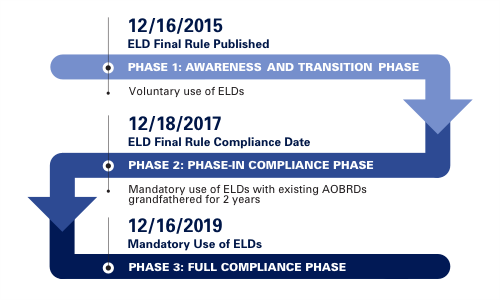ELD Mandate for Trucking Industry by FMCSA – What Should You Know?
We have collated some research on the part of the implementation of Electronic Logging Devices (ELD) in the United States. The Phase 2 (Mandatory Implementation) of ELDs began on the 18th of Dec 2017.
Here is a snapshot of the planned implementation phases.

Electronic Logging Device Implementation Timeline – FMCSA
The basic gist for ELDs is as follows:
US Department of Transport is mandating that drivers be on duty for a fixed set of hours (60 hours in 7 days, or 70 hours in 8 days; based on the breaks taken in between). There are multiple constraints was total hours of driving. This was previously implemented through basic paperwork (daily reports) in Phase 1 of their implementation. Now they are mandating electronic logging devices which can be connected directly to car’s engine to track the location, time, and speed of the vehicle. It also calculates vehicle maintenance factors.
The driver population is primarily 45-55 years of age. The population is male-dominated and is devoid of minority workforce.
- Decreased hours of service reduced their salaries.
- Increased focus on reporting and documentation added to their work.
Constant tracking of driver behavior infringed on their privacy (according to USA Today report)
The business aspect here is that as the driving hours are reduced, the salaries of the drivers also reduce (as they are many-a-times paid per mile). Many drivers have since moved on to better-paying jobs creating a shortage of skilled drivers. Some companies have upped the salaries as a result, to attract more drivers. The extra cost is turned around in the freight rates and eventually pushed to the customer.
LogiNext can help them do more with less. The constraints for the companies revolve around the driver’s timeframes (for example, they should have 30 mins break after every 8 hours; and 34-hour mandatory break after 60/70 hours) These time constraints affect the timeliness of the end-deliveries. LogiNext can create value within the existing driver working hours. It can help them structure their off-duty hours in the most optimized way which would have the least effect on their business.
We normally boast about maximizing efficiency. Here we minimize regulations and compliance impact on their daily operations.
Here are some of LogiNext’s features which could immensely benefit the trucking industry with ELD implementation.
Schedule Planning
Schedule planning can align the time-frame of each trucker with their deliveries so that they can touch maximum service and drop-off points while on-duty. There have been cases when the 34-hour break within two on-duty weeks fell right in between an active delivery route. Hence, the delivery was delayed by more than a day and a half. Companies can avoid such situations by planning proper schedules for your fleets and optimizing the routes they take.
Route Planning and Optimization
Route planning and optimization can help minimize the time spend on-road by truckers. The fleets can take shorter and less-traffic prone routes to travel higher distances and lesser time-frames. Using quicker and better routes means that the time of drivers is utilized efficiently. This cuts down the detention time and improves estimated time of arrivals (ETA).
Real-Time Fleet Tracking
Companies can track their fleet through the ELDs. Using LogiNext’s fleet management software, companies can track the trucks in real-time through a simple and interactive dashboard. This dashboard interface shows the exact location of each truck, it’s speed and its maintenance status. It also tracks exact time-lines of when, where, and for how long did the driver took his or her breaks.
Records of Duty Status / Driver Vehicle Inspection Report
LogiNext provides comprehensive analytical reports for each trip. It helps the driver and the trucking company to collate daily Records of Duty Status (RODS) reports. Similarly, they can collate the Driver Vehicle Inspection Reports (DVIR) with a single click. Every tracking detail from vehicle speed, temperature, hard braking, shift start-times, end-times, and break-times, etc. can be collated in an interactive and easy-to-understand graphical format.
Using LogiNext, trucking companies can not only ensure compliance of the ELD mandate, but can also stay one-step ahead of FMCSA with a host of other information about the driver, vehicle, and trip which is captured and analyzed by LogiNext’s system.
285 4







Pingback: This years ‘Safe Driver Week’, ensure your drivers are safer with these 5 important tips - 24/7 Customs Broker News
Pingback: LogiNext-Blog | This years ‘Safe Driver Week’, ensure your drivers are safer with these 5 important tips
Pingback: LogiNext-Blog | How to Pass a Roadside ELD Inspection Without Violations?
Pingback: LogiNext-Blog | U.S. government shutdown begins as spending bill fails in Senate